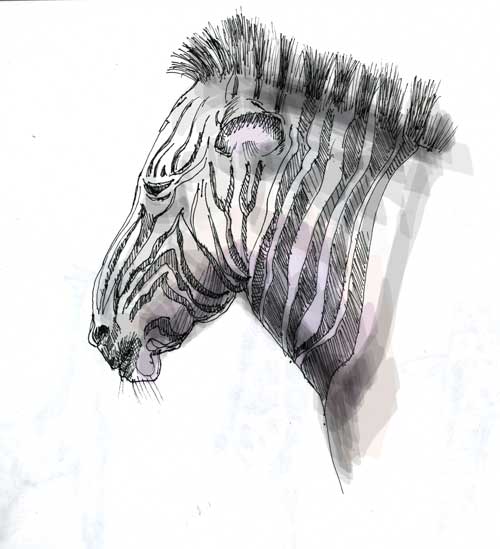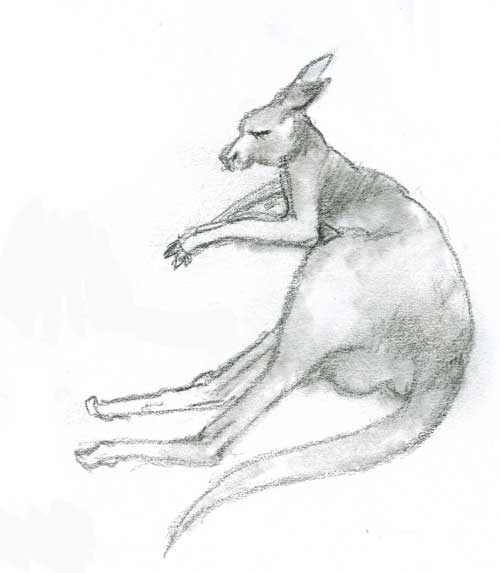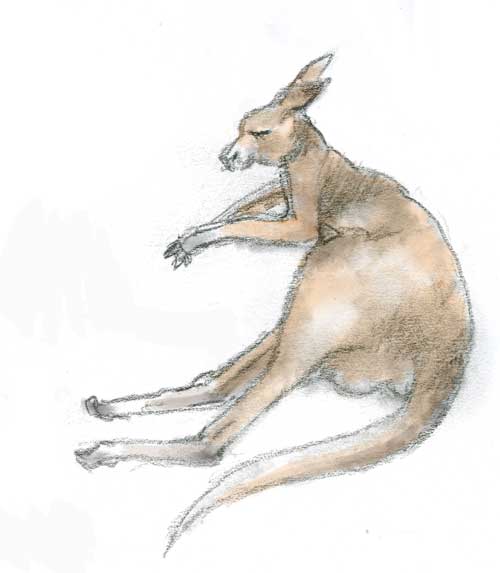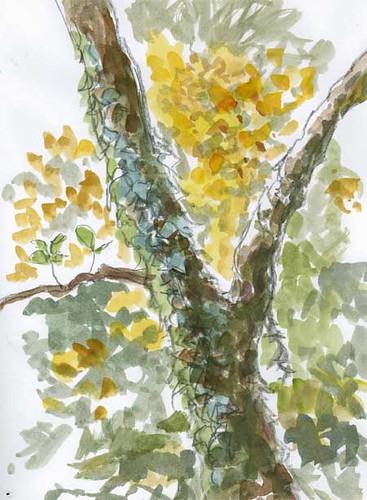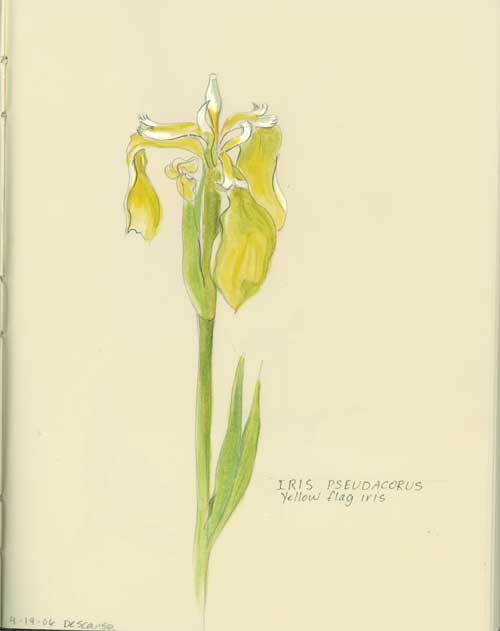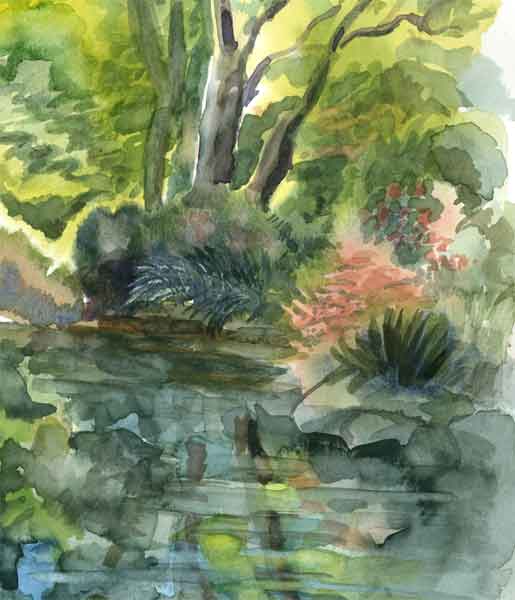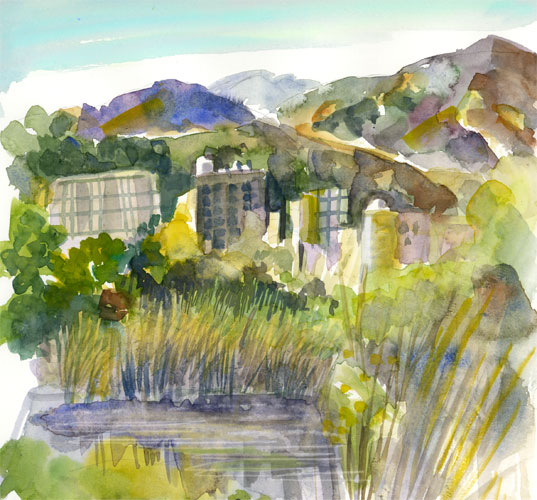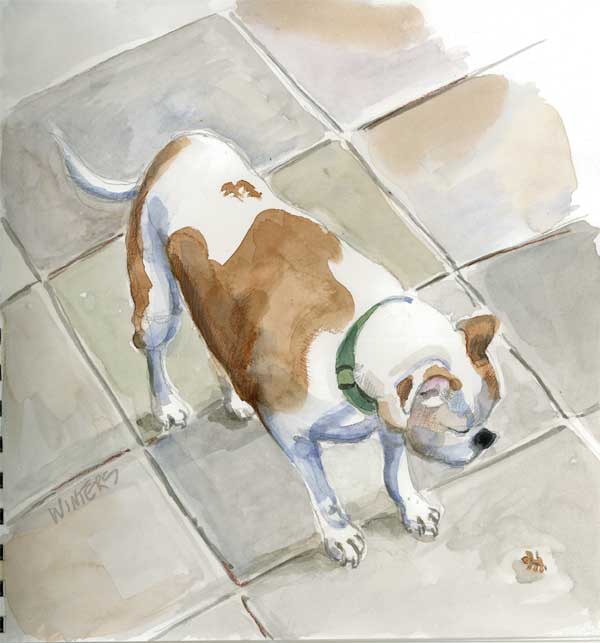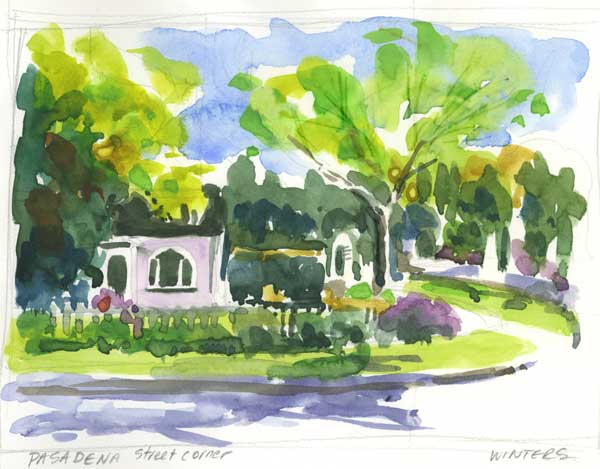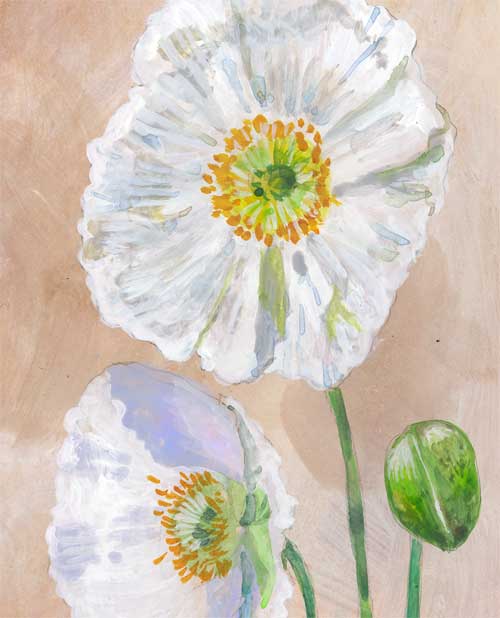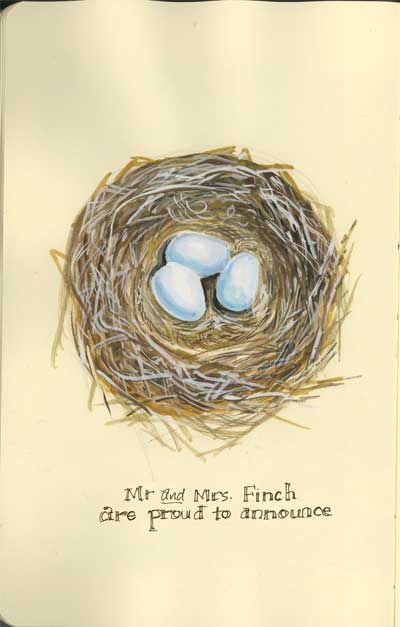Zoo Story – Part 1
On our LA Zoo sketchcrawl on Saturday, I took along a bagful of different art supplies because I wanted to experiment drawing the animals using different tools that seemed appropriate for their textures and coloration. I’m going to be scanning them and posting them throughout the week, so please check back if you’re interested in seeing more. The smooth graphic lines of the zebra seemed to lend themself to ink, and our model posed quietly in the shade for quite a long time. Thank you, zebra – you were the most cooperative subject of the day! I scanned and painted it later in Photoshop – my drawing paper doesn’t lend itself to wash.
Next subject: A mother kangaroo who had recently given birth to a little girl “joey.” Following some of the advice given in David Rankin’s Fast Sketching Techniques I used a dark, soft pencil and brought a stomp to smudge the lines. I think this captures some of the feeling of the soft fur of the mother roo who was taking a much needed rest. That big lump under her tail is where her daughter is napping! After scanning the sketch I added a little Photoshop color from a reference photo so you can see the before and after. Rankin is certainly right, drawing with a smudgeable pencil does allow you to get a faster impression with volume – good for drawing animals that won’t hold still.
If you’re in the So. California area (from Santa Barbara to San Diego to San Bernardino) and you’d like the experience of drawing with a group of friendly art-loving people, drop me a note and I’ll put you on our list so you can find out about upcoming get-togethers.
My window view – a not so faraway place
This is my return to the “Draw the view from your window” challenge. My intention is to do it for every season and to notice the differences in foliage and flowers. The tree is a Chinese elm, a hardy and vigorous grower that puts up suckers all over the yard, and promiscuously drops seeds with wild abandon. This elm, in fact, is a child of the four large elms that line the front of our property. Unlike American elms they are not vulnerable to Dutch elm disease. Come to think of it, they’re not vulnerable to anything – even severe trimming and drought. You couldn’t kill them if you tried, which makes them a good plant for drought prone areas like ours.
I painted this in my sketchbook this afternoon, looking out my window onto the end of a sunny day – a welcome change from all the rain and cloudy weather. The colors snapped, the light was good and I just had to stop what I was doing. But here’s my question: If you paint a nature scene from life but you’re not outside, can you call it plein-air? Should I call it faux-air? Or office-air? I am so confused; I will have to ruminate on this for awhile.
Edited to add:
Here’s a fall window view …of the oak just to the left of the Chinese elm (elm not seen here.)
Yellow flag
A recent entry in my ‘purely botanical’ sketchbook. This yellow flag iris is quite commonly planted around bogs or ponds. This one grows at Descanso gardens near a pond with a weeping willow. This iris, native to Asia and Europe, became known as the French fleur-de-lis, and the word “flag” may refer to a non-English word meaning rush or reed.
In some US states, pseudarcorus is considered a noxious weed because it grows by both underground tubers and reeds and can be invasive. We have a small patch of them in our yard and they have been very well contained in dry years. In very wet seasons they do spread a little bit.
Watercolor in a coptic bound Paperblanks journal with creamy paper
Three Sisters at the pool
Descanso Gardens changes by the season, the day, sometimes by the minute. Especially when the morning sun is weaving and dodging through the dense canopy of oak trees. Yesterday I was so captivated by the morning light that I spent the first hour there shooting photos for reference. In the Japanese garden, one of my favorite areas, the light was changing so rapidly that even ten minutes might highlight a plant that had been in deep shade before. Not even enough time for a wash to dry before it utterly changed. When the light is steady – either full sun or full shade – this is not so much of a problem unless there are moving clouds. Take a look at a time lapse movie and the challenge of changing light will become readily apparent.
I tried cropping this differently, and I think I like it better.
Watercolor in a Canson Montval 7 x 10 watercolor field book
Arroyo Twilight
I think I tend to be a little too conservative with color. It’s a rut I’m trying to get out of by occasionally getting experimental and pushing the colors far beyond realism. So, today my husband and I went out for a little “golden hour” painting time – the last 25 minutes of the day before the sun went behind the nearby Verdugo Hills. There wasn’t time to fiddle and fuss about being neat or getting the shapes and values right – the light was changing rapidly by the minute. I had a very good time splashing around while he read to me about Calder from today’s LA Times.
This watercolor sketch is another view of the same arroyo I painted last week – an area that is either dustbowl dry or full of water depending upon the season. Right now there are cattails in a marshy area – redwinged blackbirds everywhere and ponds full of poliwogs. It’s my idea of a great painting location.
If you draw or paint, in what areas are you ‘pushing yourself’ to be more experimental, regardless of the outcome? Are you taking chances? How does it feel when you do?
Ripley again …
It’s been a few weeks since Ripley has made an appearance here and she was calling that to my attention earlier today. So here you are.
Because I know someone will ask, I will answer it ahead of time – I did not paint this from life. In fact, here’s the secret code to to figuring out whether a particular Rip-painting has been done from life. If Ripley is sleeping or lounging in a mostly horizontal position, there’s a good chance it was done from life. If she appears to be standing up, bouncing around, digging, begging, panting or wearing a plumed hat and pearls, there’s a good chance it was painted from a photo. I do sketch her from life a lot, but mostly when the switch is set to ZZZZZZZZZZZ.
Pasadena spring
A watercolor sketch of a local streetcorner, influenced in part by a recent demo I saw by Joseph Stoddard, who is, himself, a student of Charles Reid. I think I’m going to be leaving the Niji waterbrushes behind for plein-air sketching, or else I’ll be using a lot more water for juicier washes.
Some leaf and flower studies
Last night, an art friend mentioned the book Botanical Illustration by Siriol Sherlock, and I pulled out my copy and read a little before going to bed.
Big mistake.
I turned fitfully and dreamed of impossible leaves and flowers and woke up in about two hours, probably due to Ripley snoring. But once awake, I couldn’t get those illustrations out of my mind. So I toddled down to my studio and studied some of the instructions, and then used some of my own reference photos to practice what I read on a scrap of watercolor paper. Modeling shiny surfaces wet in wet is going to take a lot of practice before I get any measure of comfort.
Do you ever get that way with an art project – where it grabs you and won’t let you go until you practice something or try something out?
White Poppy
Someone please tell me what possessed me to try to paint white poppies on a Moleskine page previously toned with darker paint? As a first attempt with a difficult flower it would have made a lot more sense to use watercolor paper and reserve the whites. But no … I had to do it the bass ackward way. The background is all acrylic – a mixture of red, blue, yellow and white. Most of the white of the poppies is acrylic, the better to cover the mottled background. Then there’s some gouache in there for shadows, and more dilute acrylic on top.
These are Iceland poppies from (where else?) Descanso Gardens. I have some matilija poppies in a pot, and when they bloom I’ll give it another try.
A nest in the west – Illo Friday Spring
For more current spring paintings from my journals … click here .
Last springtime, a finch family came looking for nesting quarters and decided that the eaves were not nearly as hospitable as one of my hanging Boston ferns. I saw the frantic search for twigs and grasses, the constant flying to and fro of the parents and before long I had a good idea that there were little ones on the way. One day when both parents were out looking for food I hurriedly took the basket down for a look (camera at the ready.) I took a picture that was the inspiration for this painting and quickly put the hanging nursery back where I found it. (There would be no drawing or painting from life for this one.) Eventually two sisters and a brother hatched, fledged, and grew to lead successful independent lives of their own. When I see finches returning in the spring I always wonder if they’re members of the same family.
Arty bits: Painted in gouache in a Moleskine sketchbook
